How to Write and Run Your First Project in Hadoop?

It may be easy to run MapReduce on small datasets without any fuss over coding and fiddling, but the only condition being you know what to do. And here is what you should know:
It may be already known to you that MapReduce works on a conceptual level. In this blog post we will discuss how you can write code that will run on Hadoop and that will start with a MapReduce program using Java.
The development environment:
To begin with we will need Java (we are using Oracle JDK 6), Git, Hadoop and Mit. You can download the latest stable version of Apache Hadoop (1.0.4) online from there release page, and then extract it to a place suitable for you.
This is what we did on our computer:
% tar zxf hadoop-1.0.4.tar.gz
% export HADOOP_HOME=$(pwd)/hadoop-1.0.4
% $HADOOP_HOME/bin/hadoop version
Hadoop 1.0.4
Then visit another directory and find the Git repository that compliments this article:
% git clone git://github.com/tomwhite/hadoop-drdobbs.git
% cd hadoop-drdobbs
% mvn install
You will find that this repository also has a small amount of sample data suitable for testing. Like this:
% cat data/*.tsv
dobbs 2007 20 18 15
dobbs 2008 22 20 12
doctor 2007 545525 366136 57313
doctor 2008 668666 446034 72694
The file has a few lines from the Google Books Ngram Dataset. For clarity here’s what they are: the first line has the word “dobbs” which appeared in the books from 2007 about 20 times almost and these occurrences were noted in more than 18 pages in 15 books.
Writing the Java MapReduce:
To find the total count for each word let us begin to write the MapReduce job. We will begin with the map function which in Java is represented with an instance of org.apache.hadoop.mapreduce.Mapper.
As a first step you must decide about the mapper is the types of the input key-value pairs and the output-key-value pairs. For the declaration of the Mapper class, here it is:
public class Mapper
As we are going to process the text, we will use the TextInputFormat. This will help us determine the input types, like LongWritable and Text, both of these are found in the org.apache.hadoop.io package. These types of Writables act as wrappers around the standard types in Java (in this case they are, long and string), this has been optimized for efficiency of serialization.
But authors of the MapReduce programs can use the Writable types without having to think about serialization. The only time they may need to consider serialization is when they write a custom Writable type. And when in such circumstances it is recommended to use a serialization library like Avro.
Coming back to the input type we can help present the input to our mapper with TextInputFormat as Longwritable, Text and pairs like this:
(0, “dobbs 2007 20 18 15”)
(20, “dobbs 2008 22 20 12”)
(40, “doctor 2007 545525 366136 57313”)
(72, “doctor 2008 668666 446034 72694”)
The key here is to use the offset within the file, and the content of the line is the value. As the mapper it is your job to extract the word along with the number of occurrences and ignore the rest. So, the output would be (word, count) pairs, of type (Text, LongWritable). The signature of the mapper should look like this:
public class ProjectionMapper extends Mapper
Then the only thing left for us to do is to write the implementation of the map() method. The source for the whole mapper class would appear in Listing One (ProjectionMapper.java).
Here’s what the Listing One: ProjectionMapper. Java looks like:
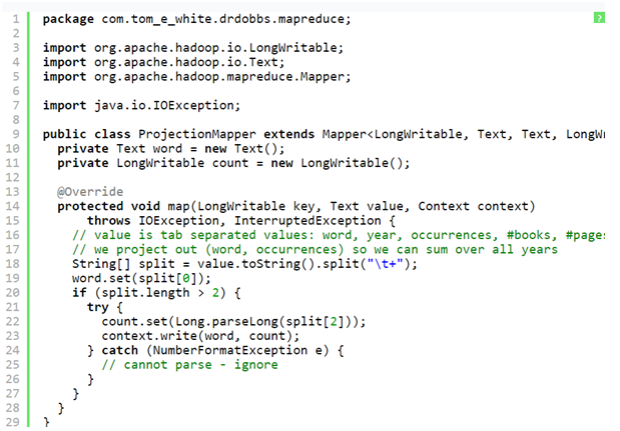
But there are certain things that one must know about this code.
- There are two instance variables, count and word which have been used to store the map output key and value.
- The map () method is known as once per input record, so it works to avoid unnecessary creation of objects.
- The map () body is pretty straightforward: it is used to split the tab-separated input line into the fields. It uses the first field as word and the third one as count.
- The map output is written with the use of the write method in the Context.
For the sake of simplicity we have built the code to ignore the lines with an occurrence field which is not a number, but there are several other actions one could take. However there are some other actions that one could take. For instance, incrementing a MapReduce counter to track how many lines are affected by it. To know more about this see, getCounter() method on Context for more information. After running through our small dataset, the map output would look like this:(“dobbs”, 20)
(“dobbs”, 22)
(“doctor”, 545525)
(“doctor”, 668666)
You must understand that Hadoop will transform the map output so that values can be brought together for a given key. The process is called the shuffle. For our abstract representation, the inputs or reducing the steps will seem somewhat like this:
(“dobbs”, [20, 22])
(“doctor”, [545525, 668666])
Most of our reduce implementation will have something to do with sum of the counts. We will require an implementation of the org.apache.hadoop.mapreduce. The reducer should be used with the following signature:
public class LongSumReducer extends Reducer<
Text, LongWritable, Text, LongWritable>
We can also try to write the code on our own, but with Hadoop we do not need to, as it comes with an implementation which is shown below in the Listing Two (LongSumReducer.java):
Listing two: LongSumReducer.java (code obtained from Apache Hadoop project) would look like this:
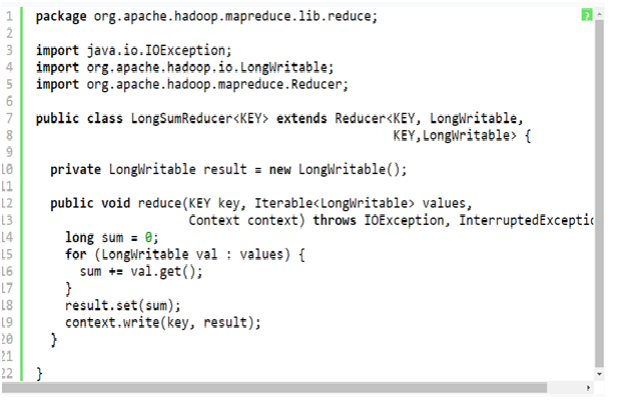
A noteworthy point to be mentioned here is, that reduce () method signature is slightly different from the map () one. That is because it contains an iterator over the values rather than just a single value. This will showcase the grouping that the framework would perform on the values for a key.
The implementation is fairly simple in the LongSumReducer: it sums the values and then writes the total out using the same key as the input.
The output for the reducer will be:
(“dobbs”, 42)
(“doctor”, 1214191)
This was the first part of this blog, for the rest of the step follow our next blog post from the premiere SAS training centre in Pune. In the next blog tranche we will reveal the procedures for the Listing three and the actual running of the job.
Interested in a career in Data Analyst?
To learn more about Machine Learning Using Python and Spark – click here.
To learn more about Data Analyst with Advanced excel course – click here.
To learn more about Data Analyst with SAS Course – click here.
To learn more about Data Analyst with R Course – click here.
To learn more about Big Data Course – click here.
You Must Learn Hadoop for These 5 Reasons
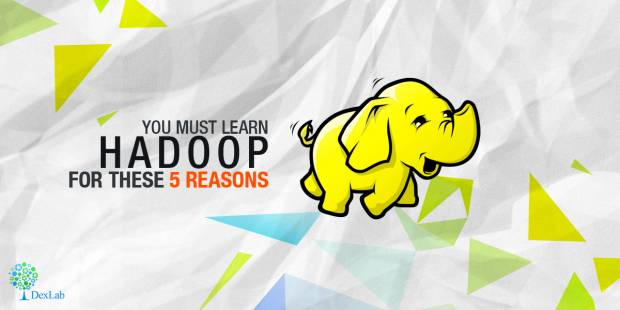
Industry insiders revealed that a Big Data Hadoop certification can make all the difference between having a dream job role and a successful career with being left behind. As per Dice all technology professionals should start volunteering for major Big Data projects which will make them more valuable to their present firms and also make them more marketable to other employers.
As per a Forbes report released in 2015, about 90 percent of global companies reported to have made medium to high levels of investment into Big Data Analytics and out of them about one third of the companies described their investments as highly important. Also about two thirds of these businesses reported that these analytics initiatives with Big Data have had a significant and measurable impact on their revenues.
People who have undergone Big Data Hadoop training are highly in demand and this is undeniable in today’s times. Thus, for IT professionals it is imperative to keep themselves abreast with the latest in trends in the Hadoop and other Big Data analytics technologies.
The main advantages with an Apache Hadoop certification to ramp your career can be summarised as the following:
- Accelerated career growth
- An increment in pay packages for having skills in Hadoop
So, it is evident that a career in Hadoop will pay well and is no rocket science.
Apache Hadoop courses offer increased job opportunities:
Assessing the Big Data market forecast the industry seems more than promising and the upward trends are clearly visible which is projected to keep progressing with time. It is safe to say that the job trend or a market phenomenon is not a short-lived feature. That is because Big Data and its technologies are here to stay. And Hadoop has the potential to improve job prospects for people whether they are fresher or an experienced professional.

Big Data Market Forecast
Avendus Capital released a research report which estimates that the IT market for Big Data analytics in India is floating around USD 1.15 billion during the end of 2015. This contributed to about 1/5th of the KPO market which is worth USD 5.6 billion. Moreover, the Hindu made a prediction which suggests that by the conclusion of the year 2018, India solely will face with a shortage as close to 2 Lakh of Data Scientists. This should present the people with tremendous career and growth opportunities.
This huge skill gap within Big Data can be bridged only by efficient learning of Apache Hadoop which enables professionals and freshers alike to add value to their resumes with Big Data skills.
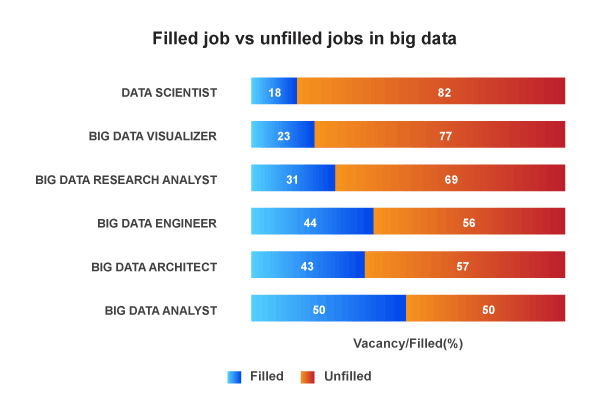
Filled Job VS Unfilled Jobs in Big Data Analyst
Thus, this is the perfect opportunity for you to take maximum advantage of a Big Data Hadoop course to reap the benefits of this positive market trend.
Who is employing Hadoop professionals?
The best place to get information on the number of existing Hadoop professionals and whose hiring is to go on LinkedIn. The graph displayed above talks about the titles of Hadoop professionals who are being hired by the top companies and which has the maximum vacancy ratio.
The word around the market is that Yahoo! is leading this rat race.
Big Data Hadoop will bring about the big bucks:
According to Dice, technology professionals should begin volunteering for the Big Data projects, which will make them more valuable to their current employing organization and make them more marketable to other employers.
Companies around the world are betting big that harnessing data can play a huge role in their competitive plans and that is leading to the high pay for their in-demand, critical skills.
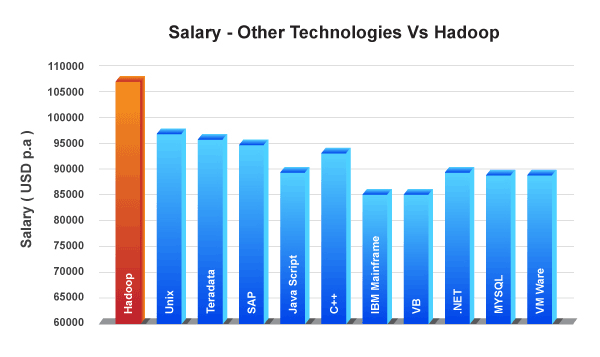
Salary – Other Technologies Vs Hadoop
As per the Managing Director of Dice, Hadoop is the leader in Big Data category in terms of job postings. And according to Dice, Hadoop professionals can make an average of USD 120,754 which is more than what Big Data jobs pay which is about USD 108,669.
Top companies that are hiring Hadoop pros:

Top Companies That are Hiring Hadoop Pros:
Interested in a career in Data Analyst?
To learn more about Machine Learning Using Python and Spark – click here.
To learn more about Data Analyst with Advanced excel course – click here.
To learn more about Data Analyst with SAS Course – click here.
To learn more about Data Analyst with R Course – click here.
To learn more about Big Data Course – click here.